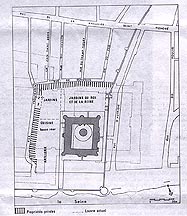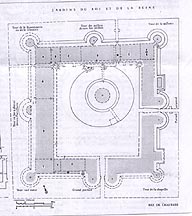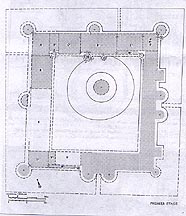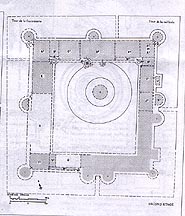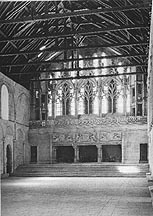Art Home | ARTH Courses | ARTH 214 Assignments |
The Louvre: the Fourteenth Century Royal Palace
The material that follows is derived from Mary Whiteley, "Royal and Ducal Palaces in France in the Fourteenth and Fifteenth Centuries: Interior, ceremony, and Function," in Architecture sociale: l'organisation intérieure des grandes demeures a la fin du Moyen Age et la Renaissance, Jean Guillaume, ed., Paris:Picard, 1994, pp. 47-63 and Mary Whiteley, "Le Louvre de Charles V: dispositions et fonctions d'une résidence royale," Revue de l'art, 97(1992), pp. 60-71:
|
Ground Floor of the Louvre: containing most prominently the Great Hall, the grande chambre du Louvre, and the Royal Chapel. |
First Floor of the Louvre: Lodgings of the Queen |
Second Floor of the Louvre: North Side: King's Chambers; East Side: Dauphin's Chambers. |
In 1364 when Charles V became king he transferred his official residence from the old palace of the Île de la Cité to the Louvre, the fortress constructed by Philippe Auguste. The remodeling was designed by Raymond du Temple. In the plan, a major division was made between the public and private spaces, each marked by a separate entrance. The major public spaces were located on the ground floor in the south and west ranges. The major public rooms were the grande chambre du roi and the adjacent grande salle located in the west range. These rooms echo the additions made by Philippe le Belle to the palais de la Cité around 1300.
The prominence of the north range which incorporated the private spaces of the king and queen is suggested by their positioning on an axis directly opposite the grand portail on the south range. The Queen's lodgings were located on the first floor while the king's were directly above on the second floor. Both the King's and Queen's chambers occupy the full north range. It is in these lodgings that we see the major changes in palace architecture. The lodgings of the King and Queen can be divided into six separate spaces diagrammed below:
|
Chambre du roi |
<-Chambre de retrait |
<-Chambre a-> parer |
Salle->
|
2
chambres
|
|
^ grande vis |
||||
One entered the private spaces through the monumental staircase called the grande vis which appeared on the central axis of the palace extending from the grand portail. The grande vis was richly decorated with sculptures. The staircase opened directly into the chambre à parer, and from there on through to the chambre de retrait and to the chambre du roi. The sequence of three rooms (chambre à parer, chambre de retrait, and the chambre du roi) were the principal rooms intended for the daytime use of the king. The chambre à parer or the chambre de parement was the great state room. This division became the standard in palace design in the late fourteenth century. Extending to the east off of the chambre à parer was a salle and two chambers intended for the king's night time use.
|
Excerpt from Christine
de Pizan, The Book of the Deeds and Good Character of King Charles
V the Wise, I.xvi, as quoted in The Writings of Christine de
Pizan, ed. Charity Cannon Willard, pp. 236- : I find a comparable
order in the case of our own wise King Charles, so that it seems to
me reasonable to recount his agreeable habit of leading a life well-regulated
in all respects, which should be an example to all who may follow be
it in empires, kingdoms, or important lordships for a well-ordered life.
The hour of his
rising in the morning was normally six or seven o'clock, and indeed
anyone who wanted to make use here of the language of poets might say
that just as the goddess Aurora, by her rising, rejoices the hearts
of those who see her, so the king gives pleasure to his chamberlains
and other servants appointed to attend his person at that hour, for,
regardless of anything that might make it otherwise, his face was joyous.
Then, after making the sign of the cross, and very devoutly addressing
his first words to God in prayer, he exchanged with his servants, in
agreeable familiarity, some pleasant and happy remarks, so that his
kindness and gentleness would encourage even the least of them to joke
and enjoy themselves with him, / p. 237 however humble they might be.
They all enjoyed these comments and exchanges. When he had been combed,
dressed, and outfitted according to the demands of the day's program,
his chaplain, a distinguished person and honorable priest, brought him
his breviary and helped him to say his hours, according to the canonical
day of the calendar. Around eight o'clock he would go to mass, which
was celebrated each day with glorious, melodious, solemn singing. In
the retirement of his oratory low masses were sung for him. As he came out of
the chapel, all sorts of people, rich or poor, ladies or maidens, widows
or others who had problems, could make their petitions to him and he
very kindly would pause to listen to their supplications, responding
charitably to those that were reasonable or piteous. More doubtful cases
he turned over to some master of requests to examine. After this, on
appointed days, he would meet with his council, and then with some noblemen
of his own blood or some clergymen who happened to be present. If some
particular lengthy matter did not prevent him, he would go to the table
around ten o'clock. His meal was not long, for he did not favor elaborate
food, saying that such food bothered his stomach and disturbed his memory,
He drank clear and simple wine, light in color, well cut, and not much
quantity nor great variety. Like David, to rejoice his spirits, he listened
willingly at the end of his meals to stringed instruments playing the
sweetest possible music. When he had risen from table after his light
meal, all sorts of strangers and others who had come with request could
approach him. There one might find several kinds of foreign ambassadors,
noblemen, and knights, of whom there was often such a crowd, both foreign
and from his own realm, that one could scarcely turn around. Nevertheless,
the very prudent king received them all and replied to them in such
a civil manner and received each one so justly with the honor due him,
that all considered themselves content and left his presence happily....
[H]e arranged what should be done according to what was proposed to
him, or promised to solve some matter in council, forbade what was unreasonable,
accorded favors, signed letters with his own hand, gave reasonable gifts,
promised vacant offices, or answered reasonable requests. He occupied
himself with such details as these for perhaps two hours, after which
he withdrew and retired to rest for about an hour. After his rest period,
he spent a time with his most intimate companions in pleasant diversions
/ p. 238, perhaps looking at his jewels or other treasures. He took
this recreation so that excessive demands on him would not damage his
health.... Then he went to vespers, after which, if it was summertime,
he sometimes went into his gardens where, if he was in his Hotel of
Saint Paul, sometimes the queen would join him with their children.
There he spoke with the women of the court, asking news of their children.
Sometimes he received curious gifts from various places, perhaps artillery
or other armaments and a variety of other things, or merchants would
come bringing velvet, cloth of gold, and all sorts of beautiful, exotic
objects, or jewels, which he had them show to the connoisseurs of such
things among members of his family. In winter, especially, he often occupied himself by having read to him fine stories from the Holy Scriptures, or the Deeds of the Romans, or Wise Sayings of the Philosophers and such matters until the hour of supper, where he took his place rather early for a light meal. After this, he spent a short period in recreation with his barons and knights before retiring to rest. And thus in continual good order, this wise and well-bread king followed the course of his life. |
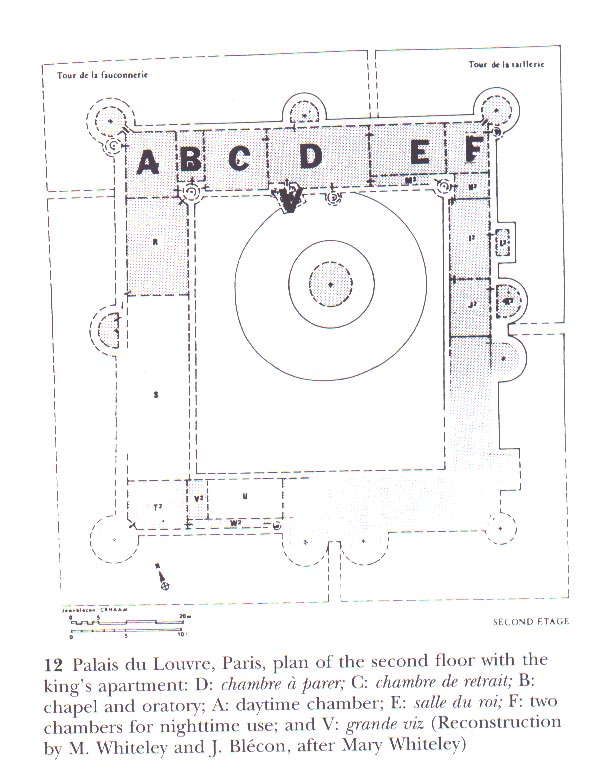
Plan of the Second Floor of the Louvre: Lodgings of the King: A: chambre; B: chapel and oratory; C: chambre de retrait; D: chambre à parer; E: salle; F: two chambres for night time use. V: grande vis (staircase leading to the chambre à parer);Lodgings of the Dauphin: H: chapel; I: chambre à parer; J: chambre; K: petite chambre; L: petite chambre. R: grande chambre du Louvre; S: grande salle (Great Hall) (extends from the ground floor into the second floor); U: Great Chapel (extends from the ground floor).

